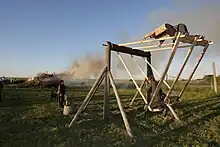Village swing
Village swing (Estonian: külakiik, Finnish: kyläkeinu) is a large swing designed for multiple adults,[1]: 14 traditionally built on village communal land,[2] in Estonia and Finland.[3][4]

History
The practice of swinging has been with Estonian culture for a long time, its origin is not known.[1]: 12 The prevalence of village swings was noted by Estophile August Wilhelm Hupel in 1781, stating "swings can be seen near almost every tavern and small village, often individual farms".[3]: 1
In recent times, authorities have begun considering village swings to be a safety hazard.[1]: 61 In 2013 the town government of Saue decided not to repair their swing because no companies were willing to accept liability in the event of damage.[5]
Kiiking
The sport kiiking was invented in Estonia in 1993, where people compete for performing a full 360 rotation with a swing. The construction of kiiking swings is radically different from village swings, but shares the cultural underpinnings.[4]
References
- Pungas, Piret (2004). "Kiigekohad Eesti maastikes" (in Estonian).
- Pungas, Piret; Oja, Tõnu; Palang, Hannes (April 2005). "Seasonality in Estonian Traditional Landscape: The Example of Large Village Swings". Landscape Research. 30 (2): 241–257. doi:10.1080/01426390500044457. ISSN 0142-6397. S2CID 146395270.
- Vissel, Anu (2002). "Eestlaste kiigekultuur enne ja nüüd" (PDF). Mäetagused (in Estonian). 21: 7–84. doi:10.7592/MT2002.21.kiik. (Translated abstract available)
- Bradshaw, Luke (17 November 2017). "Estonia and its Love for Extreme Swinging". Culture Trip. Retrieved 2020-08-04.
- Teder, Taavi (2013-06-07). "Suure külakiige tellimine jääb puuduva turvalisussertifikaadi taha". Postimees (in Estonian). Retrieved 2020-08-10.